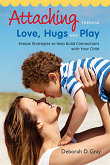Gazing at each other, playing together, skin-to-skin contact, feeding, and meeting needs—over the course of months, as parents and children repeat these activities many times, they become exclusively bonded to each other. We refer to these bonds as “attachments.” When your children believe that you will keep them safe, meet their needs, and that you are sensitive to their needs, the type of attachment that forms between you and your child is known as a secure attachment.
Attachments, by definition, are the closest of our relationships. They are exclusive. We are close with select people. People are not replaceable. We are attached to our family members, and our very best friends. We do not go up to just anybody to get our needs met. (If children do that, it is a warning sign.) Attachments are emotional. We feel strong emotions around the people to whom we are attached—love and joy when we are with them, fear and grief if our connection to them is threatened or if they are in danger. Attachments are intimate. Both physically and emotionally we open ourselves up to the other person in an attached relationship.
Attachment Takes Time
If you are trying to attach to a child who was previously parented by someone else or spent time without a close attachment figure, it can be harder to feel connected, or even confident that you are meeting the little one’s needs. You may feel that they show their needs in a confusing manner—they may seem to reach toward you, and then draw away. Or, they might seem to want something from you, but then fuss that it is the wrong thing. It is hard not to take it personally when someone does not seem to like us, but this is typical behavior for babies and children who have been neglected or are missing their former parents.
Do your best to stay sensitive and caring for the little one who is so confused. But, at the same time, recognize that you are doing something that takes an emotional toll on you. It will help to give yourself support and breaks, because it can take a long period of giving and doing the right thing until your child learns that you are caring and reliable.
If you give yourself the advantage of time, forming a relationship with your child without the stress of needing to hurry, you will find it easier to think about your child sensitively and with joy. High stress makes it harder for any of us, as parents, to be sensitive to our children.
Know that there is not a “critical window,” or a “use it or lose it” period within which children must make attachments. If you were delayed in beginning the attachment process with your child, it means that you will have to be more intentional in forming attachments. Children are wired to want to connect to parents, but after adverse situations in life, children may have difficulty responding in the way that parents expect. They want both to respond and to retreat. They are caught in the contradiction between their earlier and current parenting.
Children who have had fewer losses or stressful experiences usually have an easier time forming attachments. However, with some persistence and positivism, parents can woo even resistant little ones into secure attachments in the vast majority of cases.
Create Positive Connections Through “Emotional Looping”
Emotional looping happens when either you or your child does something to connect, the other responds, and the person who began the loop responds to the response. For example, the parent smiles, the child smiles back, and both smile, feeling good as they are aware of each other’s feelings. Positive looping is an emotional skill that healthy families encourage. Some people seem to be enjoying their relationships almost all of the time. They both expect and receive a lot of positive looping from their children.
Children who have not experienced positive looping often have not yet learned to close an “emotional loop.” The parent initiates their side of the loop and the child:
- ignores
- responds in a confusing way, with facial grimaces, or by batting at the parent
- responds very slowly, like they are in slow motion
- moves away from the parent
- grabs their parent tightly—as if capturing them.
In healthy relationships, you can expect to close many, many positive loops with your child every day. A typical day might be 15 hugs, 100 “eyes and smiles” loops (as described above), 50 positive touches or gestures, and so forth. But for children unused to the language of love, the loops are often unclosed. Children might have learned to “show off” in a cute way, but do not know how to respond when parents begin the loop.
The unclosed loops can cause you, the parent, to feel rather flat. You may have to fortify your own self-esteem, realizing that children are simply responding with what they have learned, or not learned, previously. It will take time to change your child’s reality—to understand that you want to connect with them and that you are emotionally accessible. You may also have to increase the positive intensity of your end of the looping and be intentional about using techniques that encourage attachment. I describe some of these techniques in the sections that follow.
Using Eye Contact to Engage Emotions
Eye contact with your child encourages attachment. After making eye contact, you can follow up with a smile. Think warm thoughts that cause warm feelings toward your child when you make eye contact. Children’s brains can tell the difference between “real” emotional availability and the polite, distracted signals of a preoccupied parent. Attachment is a brain-to-brain connection, so the appropriate areas of the parents’ brains need to be activated in order for children to feel the connection. What we have found is that we must engage the emotional parts of our brains in order to engage the emotional parts of their brains. If we are going through the motions, but with our minds elsewhere, we will not connect. Relaxing and enjoying the moment will engage the “right” parts of our minds.
When asking for eye contact from children, it works best if your “ask” is accompanied by a smile. If children do not respond, try to make the smile a game. Move your head into funny positions to get eye contact. Perhaps you will try getting on the floor, looking up. Stay playful, not morose or dejected. For a verbal child, for example, you might use words like, “You are letting my smile fall on the floor. Let’s pick it up and put it in our love tank.” Tap your chest to indicate the “love tank,” or heart. Parents can elaborate on this theme. “How many hearts do you think are in there? Do you have just one smile in your love tank? Do you have a hug to put in your love tank?” Tapping our hearts seems to wake up the feelings in us and in our children.
When children are just learning to form eye contact, I like to have a signal that indicates “Look at me.” I tap the bridge of my nose with a smile. The ability to maintain eye contact is neurologically based. That means that our brains need to develop the capacity to gaze at another person. Often, children are simply unable to look at parents for very long without feeling overwhelmed. It is typical for children to look, look away, look back, and once again look away. Encourage a playful, positive learning curve during which your child gradually develops the ability to gaze at you with a smile and response.
Feeling Cozy (and Safe) Enough to Cuddle
Can you remember being snuggled up to a parent or grandparent? How safe and valued you felt!
Parents yearn to give children these cozy experiences. But when infants or children are coming to parents after being in other homes, those children may still be grieving. The grief will cause them to withdraw or push away. Shock will cause them to look “dazed” and to act unresponsively. Parents may have the experience of snuggling a child who simply does not respond for quite a while.
You have every right to feel a bit let down if your child does not respond. Having a little compassion for yourself is just fine. But take a step back and feel compassion for yourself and your child; recognize that it is not your or your child’s fault that she is non-responsive. Some children have never learned to snuggle. They do not cling or hold on in a comfortable manner. Even when they are trying to hug or lap-sit as other children do, somehow they do not mold to their parents. If this is your child, let her know by words or body language that she is welcome in your lap. But you should also feel free to rearrange her in a manner that is comfortable for you. Over time, she will learn to sit comfortably as she develops some muscle memory for sitting with you.
Other children have a reaction to touch because of sensory sensitivities. People with sensory sensitivities find the typical range of stimulation overwhelming, or find that it’s not enough stimulation for them. They feel anxious and injured when overstimulated, or press into parents when seeking stimulation. These children may hang onto parents, swinging on them as if on pieces of furniture. While most children do this from time to time, these kids are non-stop. Others may say, “Ouch, that hurts!” when parents have hugged them with normal pressure. A particular child’s sensitivities may change throughout the day.
If yours is such a child, please try not to take these rejections personally. You can take a minute, finding the comfortable spacing between you and your child. I suggest being sensitive to your child’s needs, without being apologetic when you are outside their comfort zone. The attitude is a patient, “Help me to help us get this right.”
Mealtimes: Focus on Enjoyment and Connection
Eating together is a wonderful way to promote attachment. For attachment purposes, and just the joy of life, meals should be enjoyable times during which everyone relaxes around the food. I suggest that it is a “neutral zone” in which inflammatory topics are avoided. The meal is not a business meeting for the family, but a time of emotional connection.
Ideally, parents should sit down with children at the table, relaxing as they take their seats. It is best if at least two out of the three meals are unhurried. Urging children to “hurry,” “finish,” or eat more or less of a dish are prompts best avoided. Instead, mention how positive the flavors are—with shared enjoyment and eye contact. Or, mention how pleasant it is to eat with your family. For negative reactions to dishes, parents might say, “Not your favorite” or “Your taste buds have not developed for that taste—maybe next year.” The point is to establish the link between food, attachment, and pleasure. Fear or anxiety will influence appetite negatively.
Meals can present specific challenges for some children. Perhaps your child has complications due to sensory issues (the food feels like the wrong texture or the taste is too intense), or food scarcity (a background of too little food and at unpredictable times), or a difference in body rhythms due to stress (not hungry in the morning or ravenous at non-meal times). These things can be extremely stressful to any parent. You may find yourself migrating from a steady, pleasant way of providing meals to becoming anxious and controlling as you anticipate the child’s lack of appetite or finicky reaction to the food you have prepared.
Children who have a background of food scarcity will have many issues around food and attachment. If you are parenting such a child, it will help your child if you make a point of preparing and providing meals in a reliable and obvious manner. They will notice that you take seriously your responsibility of providing food. Feeding every two or three hours for smaller children or every three to four hours for older children will enable your children to recognize you as a trustworthy attachment figure. As long as children have to remind parents about meals, children still maintain the responsibility of feeding themselves.
The Fusing Power of Play
Play is one of the most enjoyable ways to build attachment with children or babies. Our brains are particularly wired to respond to play that includes:
- high excitement
- movement
- exaggerated expressions
- creativity
- body contact or close, shared physical space.
Sometimes children have not yet learned how to play. If you are parenting such a child, it can be startling to realize that your child does not seem to know how to have fun with you. Most of us think that childhood and playfulness naturally go together. Trying to play with children who are just learning to play may feel flat and one-sided for a while.
Over time, your child will come to seek out your company and understand the back-and-forth, or mutuality, of play. At first, he might be at a developmental state where he wants to play beside you but not with you. It is typical for children to want to be controlling in their play. (Controlling others comes before the developmental step of controlling ourselves.) Add some zest or excitement in the play as your child gets used to playing with you. Add elaboration and imagination, without completely taking over the play.
There are lots of games that build attachment and relationships. Play that includes drama and physical closeness will be particularly good at building relationships. Any variation of hide-and-seek tends to be fun. This can be as simple as hiding behind the edge of a baby blanket for a baby or hiding and counting for a preschooler. Hide-and-seek is a classic attachment game. All of us want to be worth the chase! Use zest and mock surprise to build excitement during the chase. Other favorite play options are:
- “Airplane” rides, in which the parent is the airplane and “flies” the child around in her arms.
- Water games that involve jumping off the parent’s shoulders, jumping into the parent’s arms, or fun with pool “noodles.”
- “Piggyback rides,” which may evolve over time to “trips” to other parts of the house and then imaginary kingdoms.
- Tickle games that include a sense of anticipation and giggly excitement by the child. (Do not tickle to the extent that the child feels helpless.)
The games build shared excitement or “high arousal,” followed by shared pleasurable experiences. This is a cycle that builds attachment.
Some parents are so intentional about attachment that they tend to do the games in a serious manner. They act as if playing with their children is one more item on their “to-do” list. The zip is gone. This rather spoils the experience. I suggest that parents enjoy the moment, giving themselves up to the spirit of the play. If you are having trouble getting a sense of joy as you play with your child, remember some of your own favorite childhood memories. It helps to borrow these memories to seed your play with a joyful attitude, even if it takes your child some time to catch up with your enthusiasm.
Physical play tends to be an open door for children and parents who are forming attachments. If you are a tired or worried parent, you may notice a tendency to select structured play, like puzzles. Puzzles are wonderful as a calming activity. But to stimulate children who are harder to connect with, physical play is a more successful activity. It allows the high excitement that fuses the connection between the two of you.
Children who have been moved between families, or who have weathered stressful beginnings, tend to run high cortisol levels, which is a measure of the stress that they are feeling. These cortisol levels ready their bodies for a physical reaction—fight or flight. Physical play gives children an outlet for the energy that their bodies are producing; it simultaneously helps them to feel better and helps them to attach. Parents who try physical play, and who let themselves get caught up in the spirit of it, find their stress reduced.
I used to run around the outside of a king-sized bed, trying to grab my children’s ankles or tickle their feet as they bounced on the mattress. Even though I might have been preoccupied with other thoughts at the beginning of the game, I soon was laughing and relaxed with the children as they dove and jumped away. I may even have benefited more than my children!

 Deborah D. Gray (
Deborah D. Gray (
